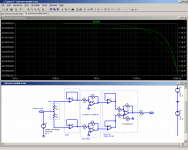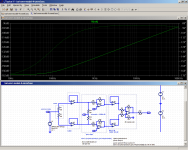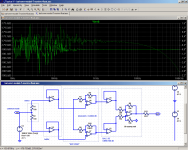I think the problem is wrong approached.
Check how the volume adjustment is done in PGA and you will understand.
The volume it is adjusted in PGA by referring to GND so differential work is for nothing.
Better convert it to unbalanced and use the PGA like in datasheet and if it is needed converted back to balanced.
No. See post # 15.
I think the problem is wrong approached.
Check how the volume adjustment is done in PGA and you will understand.
The volume it is adjusted in PGA by referring to GND so differential work is for nothing.
Better convert it to unbalanced and use the PGA like in datasheet and if it is needed converted back to balanced.
I'm with you on this. My box featured a few posts back works by running the PGA single ended with balanced receivers and line drivers around it. And as a professional engineer in the broadcast business for 35 years, I can tell you that's how it's done in commercial products.
Now I have not really analyzed the balanced PGA approach but it just seems like more of this audiophile nirvana where at the end of the day there is no audible difference.
Now I have not really analyzed the balanced PGA approach
Are you planning to?
Jan
Are you planning to?
Jan
Well considering I already built my VCA box and then expanded it to 24 channels by adding another 8 channel board, i'm good.
My system is an Atmos HT system with 22 channels as the LCR's are triamped. That's why I need so many channels. This box is after the DACS.
So as it's running at +4, what exactly do I gain sonically by converting to a balanced PGA configuration? The SSM2141 and 2142 are well reviewed.
No one claimed 'nirvana' on anything wrt to running the PGA in balanced mode.
I wanted balanced in and balanced out so the approach seemed like a sensible way to do it.
It worked very well and I'd be happy to go back to using it again.
I'm quite familiar with integrated balanced line drivers and receivers as well.
I wanted balanced in and balanced out so the approach seemed like a sensible way to do it.
It worked very well and I'd be happy to go back to using it again.
I'm quite familiar with integrated balanced line drivers and receivers as well.
I was referring to a circuit like Bonsai's (or proposed by the OP), with single-ended buffers feeding two channels of the PGA directly. Common mode to differential mode conversion depends on channel tracking there. I haven't done the math in a while, but asking for 60 dB of CMRR (which would be a decent value for a line-level input though not SOTA) would require matching on the order of 0.1% or 0.01 dB. The part is specified for +/- 0.1 dB, no idea how good it is in real life.
Get why I'm seeing a potential problem there?
. . . you cant get an earth loop through an opamp input. So buffering the inputs before feeding the PGA input attenuator is as good as isolating them. Ditto the output circuit as well. The only issue you have is gain balance - but the PGA is pretty good in that respect.
No one claimed 'nirvana' on anything wrt to running the PGA in balanced mode.
I wanted balanced in and balanced out so the approach seemed like a sensible way to do it.
It worked very well and I'd be happy to go back to using it again.
I'm quite familiar with integrated balanced line drivers and receivers as well.
I enjoyed looking through your website!
(Which is not to say that yours truly wouldn't have!  )
)
Here's a lil' sim for you guys. I placed a very slightly mismatched "gain stage" between a buffer and an ideal bal/SE converter and fed a pure common mode signal into it. If not mismatched, attenuation is 180 dB, which is to say infinite within computational accuracy.
Increase one 10k resistor by 10 ohms (+0.1%), and you get 0.864 dB of gain mismatch or a CMRR of -60 dB, both inverting and noninverting. This mismatch converts part of the CM signal to differential. (The bal/SE converter on its own has ~infinite CMRR.)
I also tried the trick of referring the gain stage to a common-mode signal, and it does work quite well, though clearly some work on part of the opamp is involved so its effectiveness diminishes towards the higher freqs (still very good though). For a noninverting type of gain stage this reference would have to be buffered. Not sure about the noise penalty.
Connecting the two noninverting amps together INA style works great though, CMRR is up to maximum possible again. Not sure whether that'll fly with a PGA, but worth a try I suppose.
Here's a lil' sim for you guys. I placed a very slightly mismatched "gain stage" between a buffer and an ideal bal/SE converter and fed a pure common mode signal into it. If not mismatched, attenuation is 180 dB, which is to say infinite within computational accuracy.
Increase one 10k resistor by 10 ohms (+0.1%), and you get 0.864 dB of gain mismatch or a CMRR of -60 dB, both inverting and noninverting. This mismatch converts part of the CM signal to differential. (The bal/SE converter on its own has ~infinite CMRR.)
I also tried the trick of referring the gain stage to a common-mode signal, and it does work quite well, though clearly some work on part of the opamp is involved so its effectiveness diminishes towards the higher freqs (still very good though). For a noninverting type of gain stage this reference would have to be buffered. Not sure about the noise penalty.
Connecting the two noninverting amps together INA style works great though, CMRR is up to maximum possible again. Not sure whether that'll fly with a PGA, but worth a try I suppose.
Attachments
Last edited:
The PGA2320 gain mismatch is quoted as 0.1dB typical at max gain of 31.5 dB. If my (very) rusty math is right, that's a ~500ppm gain delta. No guarantees of course that it will hold across all gain settings, but being on the same chip does help. 60 dB CMRR is still respectable and THAT sell a line receiver (1250 series) spec'd at <60 dB CMRR and much lower with source impedance imbalances of 20~30 Ohms. The more expensive THAT1200 series do 90 dB CMRR (these work very well BTW) and can handle source imbalanced with no degradation in CMRR.
The PGA2320 gain mismatch is quoted as 0.1dB typical at max gain of 31.5 dB. If my (very) rusty math is right, that's a ~500ppm gain delta. No guarantees of course that it will hold across all gain settings, but being on the same chip does help. 60 dB CMRR is still respectable and THAT sell a line receiver (1250 series) spec'd at <60 dB CMRR and much lower with source impedance imbalances of 20~30 Ohms. The more expensive THAT1200 series do 90 dB CMRR (these work very well BTW) and can handle source imbalanced with no degradation in CMRR.
I never looked at the THAT chip seroiusly. But at work we have quite a few 5.1 and 7.1 pro monitoring boxes that use the THAT VCA.
Rod Elliot also like the THAT chip.
As I said before, 2311 differential didn't sound good, and RMAA result was less than impressive. This board is in my junk box now. I thought it was due to rather poor PSU implementation, but I think properly dithered digital volume control is much better, if the goal is transparency. 
I'm using the 1200 - very nice. I think its about $2.50 at Mouser.
"1200"
Full p/n?
Just interested to increase knowledge.
- Status
- This old topic is closed. If you want to reopen this topic, contact a moderator using the "Report Post" button.
- Home
- Source & Line
- Analog Line Level
- Balanced PGA2311 volume control


